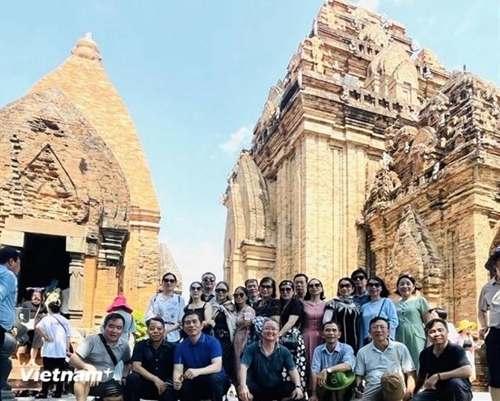Dubbed the “land of ancient towers,” Khanh Hoa boasts a rich Cham legacy through architectural masterpieces like the Po Nagar, Hoa Lai, Po Klong Garai, and Po Rome towers. Among them, the Po Klong Garai and Po Nagar complexes stand out for their historical significance, aesthetic appeal, and cultural value.
    |
 |
|
Visitors at the Ponagar Cham Tower (Photo: vietnamplus.vn) |
Perched on Trau Hill in Do Vinh ward, the Po Klong Garai complex, built between the late 13th and early 14th centuries, pays tribute to King Po Klong Garai (1151–1205), revered for his contributions to local irrigation and agriculture. The site includes the Main Tower, Fire Tower, and Gate Tower, with the 20.5m Main Tower boasting intricate designs and distinctive red baked bricks. Its construction technique, which allows bricks to seamlessly interlock without visible mortar, remains an unsolved mystery, adding to its enigmatic allure.
The complex is the heart and soul of the Cham Balamon community in southern Khanh Hoa, especially during the annual Kate Festival between late September and early October. This site, together with the Hoa Lai tower, was designated a Special National Monument in 2016. In 2024, the statue of King Po Klong Garai was officially recognized as a National Treasure.
Not far away, the Po Nagar Tower complex, set on Cu Lao Hill overlooking the Cai River in northern Nha Trang, is dedicated to the goddess Po Nagar (Thien Y A Na), the protector of land and people. Built between the 8th and 13th centuries, this site has been through historical upheavals but still radiates spiritual magic. Its Mandapa hall, with distinctive octagonal brick columns, and a cluster of towers, pull in thousands of visitors annually. On July 10, the Po Nagar Tower complex was officially recognized as a Special National Monument. Its intangible cultural value shines during the annual Po Nagar Festival held from the 20th to 23rd of the third lunar month.
The Cham’s sophisticated bricklaying technique, with nearly invisible joints, continues to puzzle researchers. Intricate carvings of deities, dancers, and sacred animals, though worn by time, vividly reflect Hinduism’s profound influence on Cham artistry and spirituality.
To keep this legacy alive, Director of the provincial Department of Culture, Sports, and Tourism Nguyen Van Hoa said local artisans from Bau Truc pottery village and My Nghiep weaving village put on traditional craft shows at Po Klong Garai. Tourists get a treat with Cham folk music and dance performances on weekends and holidays, plus two epic shows, “Lung Linh Xu Tram” and “Trang Soi Dang Thap” staged on the first and 15th of each lunar month.
The towers have also become popular check-in spots, with visitors donning traditional Cham attire for photos.
Source: VNA